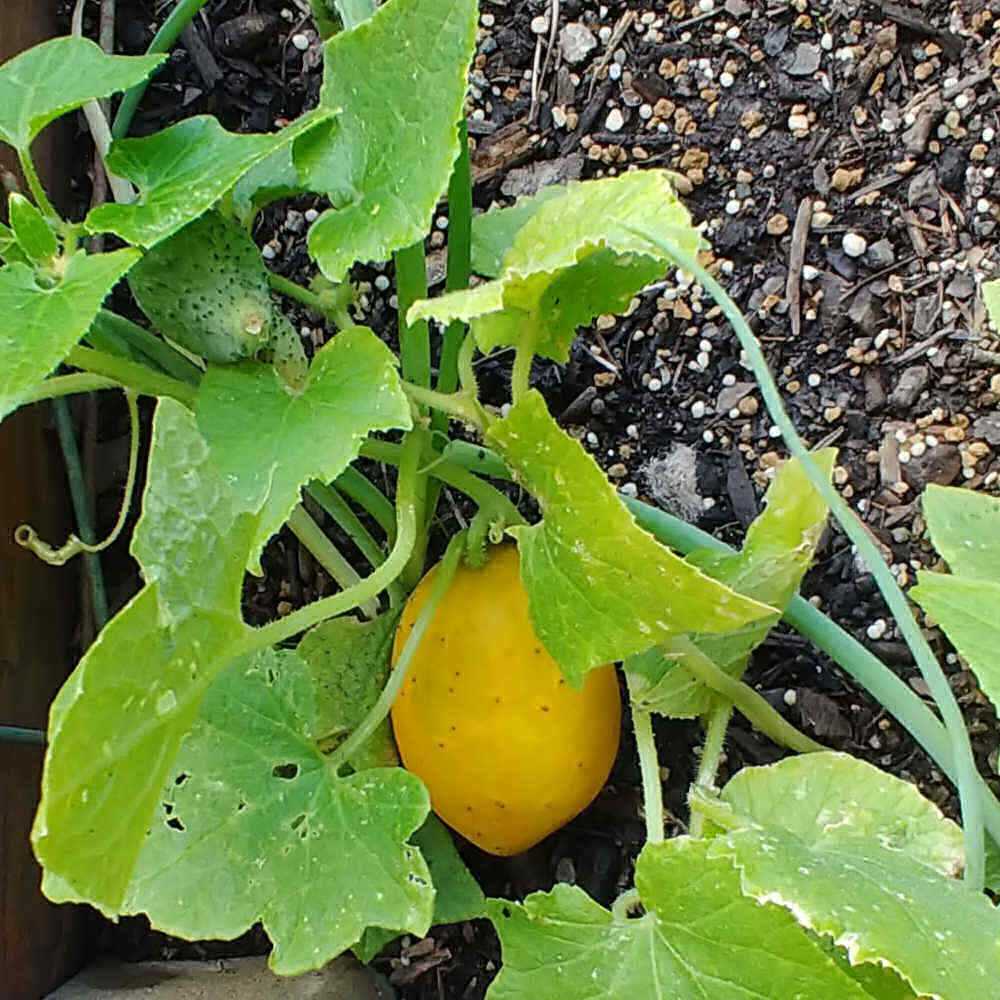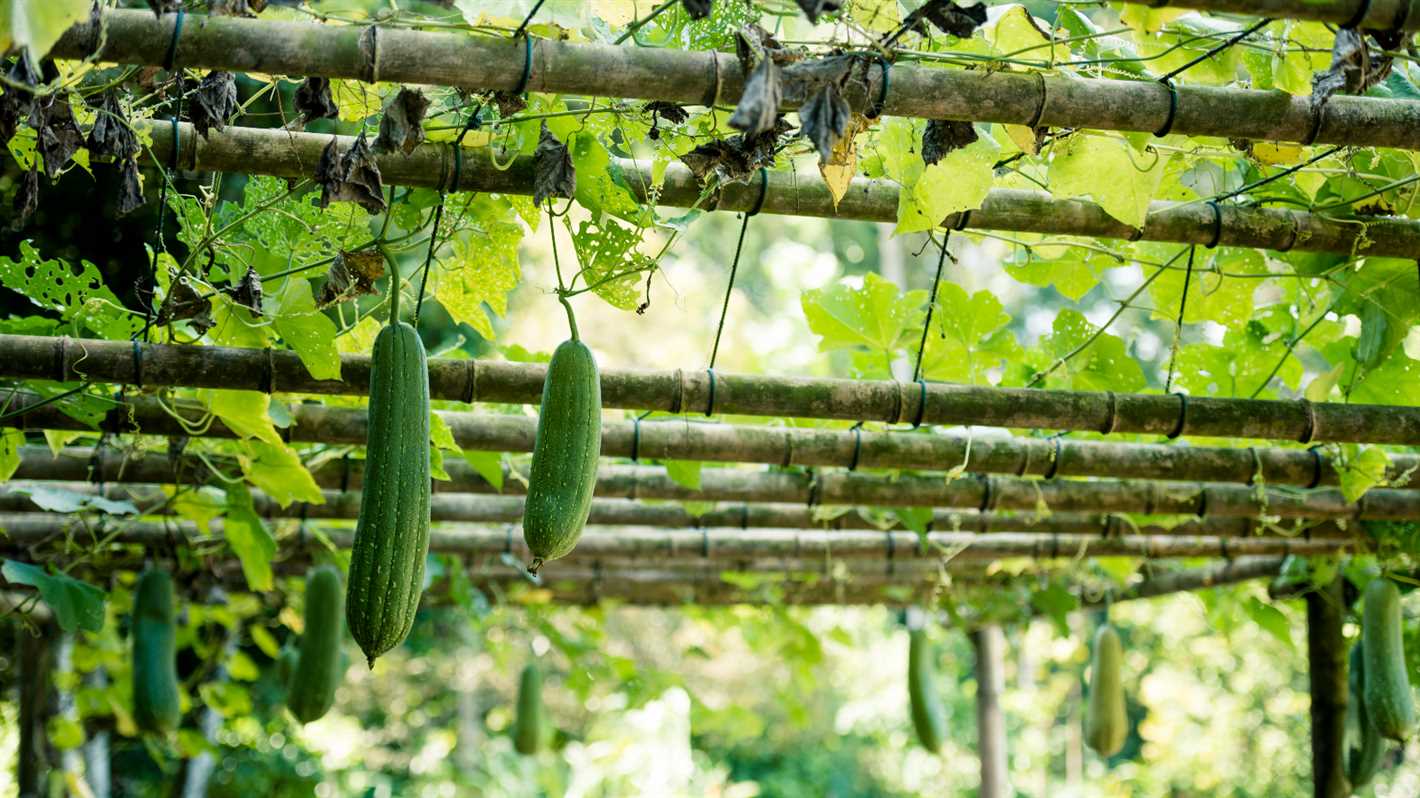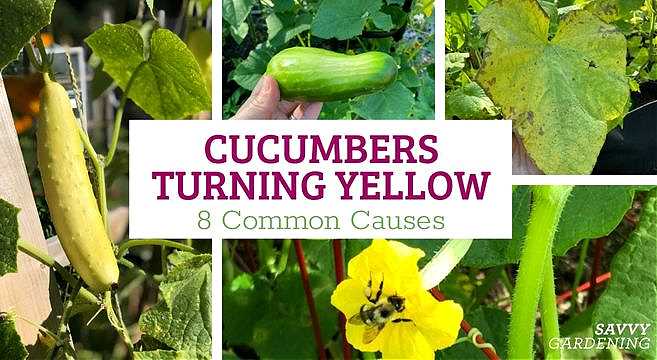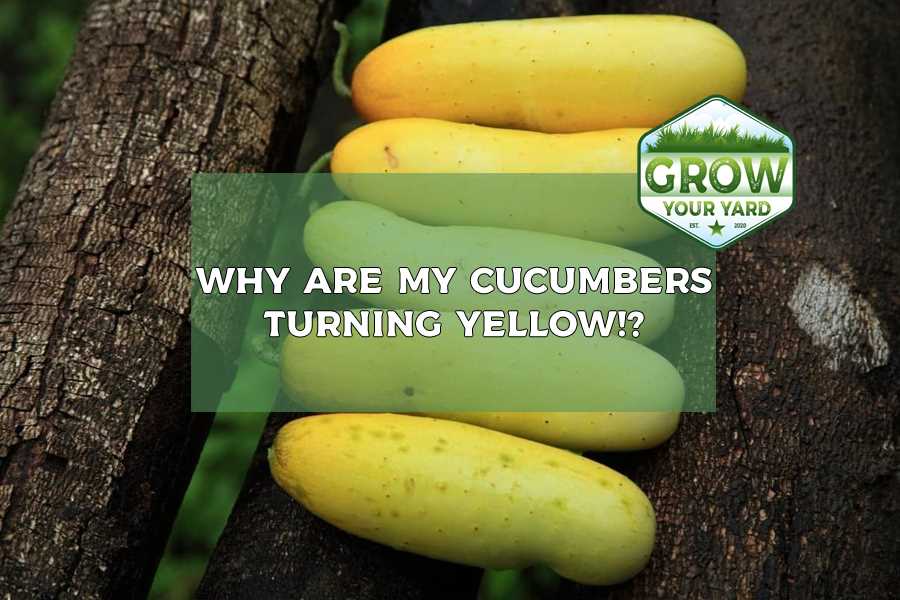- Common Causes of Yellow Cucumbers
- 1. Overripe or Mature Cucumbers:
- 2. Inadequate Pollination:
- 3. Nutrient Deficiencies:
- 4. Watering Issues:
- 5. Pests or Diseases:
- 6. Environmental Stress:
- Overwatering
- Nutrient Deficiencies
- 1. Nitrogen Deficiency
- 2. Iron Deficiency
- 3. Magnesium Deficiency
- 4. Potassium Deficiency
- 5. Other Micronutrient Deficiencies
- Pest Infestations
- Inappropriate Temperature
- Poor Pollination
- 1. Attract Pollinators
- 2. Hand Pollination
- Diseases and Fungal Infections
- 1. Downy Mildew
- 2. Powdery Mildew
- 3. Bacterial Wilt
- 4. Cucumber Mosaic Virus
- Genetic Factors
- Environmental Stress
- “Question-Answer”
- What could be causing cucumbers to turn yellow in the greenhouse and vegetable garden?
- How can I prevent cucumbers from turning yellow in the greenhouse and vegetable garden?
- What nutrient deficiencies can cause cucumbers to turn yellow?
- How can I determine if my cucumbers are suffering from a pest infestation?
- Can diseases be the reason behind cucumbers turning yellow?
- What should I do if I find out that my cucumbers are suffering from a pest infestation?
- “Video” 3 Reasons Your Cucumber Plants Suddenly Wilt
As a gardener, it can be disappointing to see your cucumbers turning yellow instead of the vibrant green color you were expecting. However, there are several reasons why this may be happening in both greenhouse and outdoor vegetable garden environments. Understanding these factors can help you address the issue and ensure a successful crop.
One common cause of yellowing cucumbers is inadequate pollination. Cucumbers rely on bees and other pollinators to transfer the pollen from the male flowers to the female flowers, where the fruit is formed. If there is a lack of pollinators or if the weather conditions are unfavorable for pollination, the cucumbers may turn yellow and fail to develop properly. To encourage pollination, you can try attracting more pollinators to your garden or greenhouse, or even hand-pollinate the flowers yourself.
Another factor that can contribute to yellow cucumbers is nutritional deficiencies. Cucumbers require a balanced supply of nutrients, particularly nitrogen, phosphorus, and potassium, to grow and thrive. If the soil is lacking in these essential nutrients, the plant may struggle to produce healthy green cucumbers. Conducting a soil test and amending the soil with organic matter or fertilizer can help address any deficiencies and promote healthy cucumber growth.
Excessive moisture or improper watering practices can also cause cucumbers to turn yellow. Overwatering can lead to root rot and nutrient leaching, while underwatering can result in stress and nutrient imbalances. It’s important to provide cucumbers with consistent moisture levels, allowing the soil to dry slightly between waterings. Additionally, ensure that your greenhouse or garden has proper drainage to prevent waterlogged conditions.
Pests and diseases can also be a culprit for yellowing cucumbers. Common pests, such as aphids and cucumber beetles, can damage the leaves and disturb the nutrient uptake of the plant, leading to yellowing. Similarly, diseases like cucumber mosaic virus or fusarium wilt can also cause yellowing and other symptoms. Regular inspection and proper pest control measures, such as using organic insecticides or practicing crop rotation, can help prevent and manage these issues.
In conclusion, there are several factors that can cause cucumbers to turn yellow in both greenhouse and vegetable garden settings. Inadequate pollination, nutritional deficiencies, improper watering, and pests or diseases can all contribute to this issue. By addressing these factors and implementing the necessary measures, you can ensure healthier and greener cucumbers in your garden or greenhouse.
Common Causes of Yellow Cucumbers

When cucumbers in your greenhouse or vegetable garden start turning yellow, it can be an indication of various problems. Here are some common causes:
1. Overripe or Mature Cucumbers:
An obvious reason for yellow cucumbers is that they are simply overripe or mature. As cucumbers age, their color changes from green to yellow. It is important to harvest cucumbers before they reach this stage to ensure maximum freshness and taste.
2. Inadequate Pollination:
Cucumbers require proper pollination to develop properly. If pollination is inadequate, the cucumbers may turn yellow and fail to grow to their full size. Lack of pollination can be caused by factors such as a lack of pollinators or poor weather conditions. To ensure proper pollination, you can hand-pollinate the flowers using a small brush or encourage pollinator-friendly plants in your garden or greenhouse.
3. Nutrient Deficiencies:
Yellowing cucumbers can also be a result of nutrient deficiencies. Cucumbers require a balanced supply of nutrients, including nitrogen, phosphorus, and potassium, among others. Insufficient nutrients in the soil can cause the plants to yellow and produce unhealthy cucumbers. Testing the soil and providing appropriate fertilizer can help address nutrient deficiencies.
4. Watering Issues:
Inconsistent or improper watering practices can also lead to yellow cucumbers. Overwatering or underwatering can stress the plants, affecting their health and fruit development. It is important to maintain a consistent watering schedule and ensure that the soil is well-drained but moist. Mulching around the plants can help retain moisture and regulate soil temperature.
5. Pests or Diseases:
Yellowing cucumbers can be a symptom of pest infestations or diseases. Common pests that can affect cucumbers include aphids, cucumber beetles, and spider mites. These pests feed on the plants, causing damage and yellowing. Diseases such as cucumber mosaic virus and powdery mildew can also cause the leaves and fruits to turn yellow. Proper pest control measures and regular monitoring can help prevent and manage these issues.
6. Environmental Stress:

Exposure to extreme weather conditions or environmental stressors can lead to yellow cucumbers. Factors such as high temperatures, excessive sunlight, or improper humidity levels can affect the plants’ health and result in yellowing. Providing shade, using shade cloth, or adjusting the greenhouse environment can help minimize stress and maintain optimal growing conditions for cucumbers.
By identifying the common causes of yellow cucumbers, you can take appropriate measures to address the issues and ensure healthy and vibrant cucumber plants in your greenhouse or vegetable garden.
Overwatering
Overwatering is one of the common causes of cucumber plants turning yellow in the greenhouse and vegetable garden. When plants are overwatered, their roots become waterlogged, leading to poor oxygen flow and nutrient uptake. This can result in the leaves turning yellow.
Overwatering can also create a favorable environment for the development of fungal diseases, such as root rot. These diseases can further inhibit the plant’s ability to take up nutrients, leading to nutrient deficiencies and yellowing leaves.
In order to prevent overwatering, it is important to monitor the moisture levels of the soil. One way to do this is by checking the soil moisture using a moisture meter or by sticking your finger about an inch into the soil. If the soil feels wet or moist, it is an indication that the plant does not need to be watered yet.
Additionally, it is important to establish a watering schedule based on the specific needs of cucumber plants. Generally, cucumber plants require regular watering, but the frequency will depend on factors such as temperature, humidity, and soil type. It is best to water the plants deeply and less frequently rather than shallow watering frequently.
Improving the drainage of the soil can also help prevent overwatering. This can be done by adding organic matter, such as compost, to the soil to improve its structure and drainage. Avoiding planting cucumbers in heavy clay soils can also help prevent overwatering.
By properly managing watering practices and ensuring good drainage, you can help prevent cucumbers from turning yellow due to overwatering.
Nutrient Deficiencies

Nutrient deficiencies can also cause cucumber plants to turn yellow in both the greenhouse and the vegetable garden. It is important to ensure that the plants are receiving a balanced and adequate supply of nutrients for healthy growth.
1. Nitrogen Deficiency

A nitrogen deficiency can cause the leaves of cucumber plants to turn yellow. Nitrogen is an essential nutrient for plant growth and is required for producing chlorophyll, which gives leaves their green color. Without enough nitrogen, the leaves may become pale or yellow. To address a nitrogen deficiency, you can apply a nitrogen-rich fertilizer or organic matter such as compost to the soil.
2. Iron Deficiency
An iron deficiency can also lead to yellowing of cucumber leaves. Iron is important for chlorophyll production and a lack of iron can result in chlorosis, a condition where the leaves lose their green color and turn yellow. To address an iron deficiency, you can apply iron chelates or iron sulfate to the soil following the recommended application rates.
3. Magnesium Deficiency
A magnesium deficiency can cause yellowing of older leaves while the veins remain green. Magnesium is necessary for chlorophyll formation, and a deficiency can result in chlorosis. To address a magnesium deficiency, you can apply magnesium sulfate or Epsom salts to the soil.
4. Potassium Deficiency
A potassium deficiency can cause yellowing or browning of leaf edges and tips. Potassium is involved in various metabolic processes in plants and is important for overall plant health and vigor. To address a potassium deficiency, you can apply potassium-rich fertilizers or organic amendments such as wood ash to the soil.
5. Other Micronutrient Deficiencies
In addition to nitrogen, iron, magnesium, and potassium, cucumber plants also require other micronutrients in smaller quantities. Deficiencies in these micronutrients, including zinc, manganese, and copper, can also lead to yellowing and other symptoms. Applying a balanced fertilizer or micronutrient supplements can help address these deficiencies.
It is important to monitor the nutrient levels in the soil and adjust fertilization accordingly to prevent and correct nutrient deficiencies. Conducting a soil test and consulting with a gardening expert can help identify specific deficiencies and determine the appropriate course of action.
Pest Infestations
Pests can also be a common cause of cucumbers turning yellow in greenhouses and vegetable gardens. These pests can damage the cucumber plants, leading to yellowing of the leaves and fruits. Here are some of the most common pests that can infest cucumber plants:
- Aphids: These small insects feed on the sap of the cucumber plant, causing stunted growth, yellowing, and distortion of the leaves. They can also transmit viruses to the plants.
- Spider mites: These tiny pests suck the sap from the leaves, resulting in yellowing, wilting, and webbing on the undersides of the leaves.
- Thrips: These slender insects feed on the plant tissues, causing silvering or bronzing of the leaves and yellow spots on the fruits.
- Whiteflies: These tiny, white insects also feed on the sap of the cucumber plant, leading to leaf yellowing, wilting, and the development of a sticky substance called honeydew.
- Cucumber beetles: These beetles are known to feed on the leaves, stems, and fruits of cucumber plants, causing yellowing, wilting, and damage to the plant tissues.
If you suspect a pest infestation in your cucumber plants, it is important to take immediate action to control them. This can include using insecticidal soaps, neem oil sprays, or other natural or chemical pest control methods. Regularly inspecting your plants and applying preventive measures, such as removing weeds and planting companion plants that repel pests, can also help to prevent infestations.
In severe cases, when the infestation is widespread, it may be necessary to remove and destroy heavily infested plants to prevent the spread of pests to other plants.
Inappropriate Temperature
- High Temperature: Cucumbers are sensitive to high temperatures, especially in the greenhouse. When the temperature gets too hot, the plants may experience a phenomenon called heat stress. This can cause the leaves to turn yellow. To prevent this, it is important to provide adequate ventilation and shade in the greenhouse to keep the temperature within a suitable range for cucumber growth.
- Low Temperature: On the other hand, if the temperature drops too low, it can also cause cucumber plants to turn yellow. Cold temperatures can lead to nutrient uptake problems, as well as slow down the growth and development of the plants. In order to avoid this, it is important to maintain a consistent temperature in the greenhouse and protect the plants from frost if necessary.
In conclusion, inappropriate temperature conditions, both too high and too low, can result in yellowing of cucumber plants in the greenhouse and vegetable garden. It is essential to monitor and control the temperature to ensure optimal growth and prevent heat or cold stresses that can cause the leaves to yellow.
Poor Pollination
Poor pollination can also lead to yellow cucumbers in both the greenhouse and vegetable garden. Cucumbers require pollination to develop properly, as this process helps in the formation of healthy fruits. Poor pollination can be caused by a lack of pollinators, such as bees, or unfavorable weather conditions that prevent pollination from occurring.
When cucumbers are not adequately pollinated, they may develop into small, misshapen, and yellow fruits. The lack of pollination affects the fertilization of the flowers, resulting in incomplete development and yellowing of the cucumber.
To improve pollination in your greenhouse or vegetable garden, consider the following:
1. Attract Pollinators
- Plant flowers that attract pollinators, such as bees, butterflies, and hummingbirds, near your cucumber plants.
- Provide a water source for pollinators, like a shallow dish with fresh water.
- Avoid using pesticides that are harmful to bees and other pollinators.
2. Hand Pollination
If there is a lack of pollinators or unfavorable weather conditions, you can manually pollinate the cucumber plants.
- Select a male flower (identified by its long stem) and gently remove its petals.
- Gently shake the male flower over the center of a female flower (identified by the tiny cucumber fruit at its base) to transfer the pollen.
- Repeat this process with multiple male flowers to ensure adequate pollination.
By attracting pollinators or manually pollinating your cucumber plants, you can help ensure proper pollination and reduce the likelihood of yellow cucumbers in your greenhouse or vegetable garden.
Diseases and Fungal Infections
Yellowing of cucumbers in greenhouses and vegetable gardens can also be caused by various diseases and fungal infections. These can affect the leaves, stems, and fruits of cucumber plants, leading to yellowing and other symptoms.
1. Downy Mildew
- Downy mildew is a common cucumber disease caused by the fungus Pseudoperonospora cubensis.
- Affected cucumber plants develop yellow spots on their leaves, with a downy appearance on the undersides.
- As the disease progresses, the spots may turn brown or necrotic, and the leaves may ultimately die and fall off.
- Mildew-infected fruits may also show yellowing and have a bitter taste.
- Proper ventilation, spacing, and fungicide application can help prevent and control downy mildew.
2. Powdery Mildew
- Powdery mildew, caused by various fungal species including Podosphaera xanthii and Erysiphe cichoracearum, is another common cucumber disease.
- Infected plants develop a white powdery growth on their leaves, stems, and fruits.
- The affected areas may then turn yellow or brown, and the leaves may become distorted and die.
- Proper spacing, good air circulation, and fungicide application can help control powdery mildew.
3. Bacterial Wilt
- Bacterial wilt, caused by the bacterium Erwinia tracheiphila, is a serious disease that affects cucumbers.
- Infected plants show wilting, yellowing of leaves, and a sudden collapse of the entire plant.
- This disease is primarily spread through cucumber beetles.
- Controlling cucumber beetles with insecticides and removing infected plants can help prevent the spread of bacterial wilt.
4. Cucumber Mosaic Virus
- Cucumber mosaic virus (CMV) is a common viral disease that affects cucumbers and other vegetable crops.
- Infected plants show mosaic patterns of light and dark green on leaves, which may also become yellow or stunted.
- CMV can be transmitted by aphids or through infected seeds.
- Controlling aphids, removing infected plants, and using virus-free seeds can help prevent CMV.
These are just a few examples of the diseases and fungal infections that can cause yellowing of cucumbers in greenhouses and vegetable gardens. It is important to regularly inspect plants for any signs of disease or infection and take appropriate measures to prevent their spread.
Genetic Factors
Genetic factors play a significant role in the yellowing of cucumbers in both the greenhouse and vegetable garden. Some cucumber varieties are genetically predisposed to developing yellow leaves at certain stages of growth or under particular environmental conditions.
These genetic factors can cause physiological changes in cucumber plants that affect their ability to produce and transport chlorophyll, the pigment responsible for the green color in leaves. When the production or transport of chlorophyll is impaired, the leaves may turn yellow.
Additionally, certain genetic traits may contribute to the susceptibility of cucumber plants to various diseases and pests. Cucumber plants with weak genetic resistance may be more prone to infections and infestations, which can lead to yellowing of leaves as a secondary effect.
To mitigate the impact of genetic factors on cucumber yellowing, it is essential to select cucumber varieties that are known for their resistance to diseases and pests. Additionally, providing optimal growing conditions, such as proper nutrition, appropriate watering, and suitable temperature and light levels, can help alleviate the negative effects of genetic factors on cucumber plants.
Environmental Stress
Environmental stress can contribute to cucumber plants turning yellow in the greenhouse and vegetable garden. This can be caused by various factors, including:
- Temperature fluctuations: Cucumber plants are sensitive to temperature changes, especially extreme heat or cold. Exposure to temperatures outside of their preferred range can cause stress and lead to yellowing of leaves.
- Inadequate sunlight: Cucumbers require a significant amount of sunlight to grow properly. If they are not receiving enough light, the chlorophyll production in the leaves can be affected, resulting in yellowing.
- Water stress: Overwatering or underwatering can both stress cucumber plants and cause yellowing. Inconsistent watering or improper drainage can lead to root issues and nutrient deficiencies, affecting the plant’s overall health.
- Nutrient deficiencies: Lack of essential nutrients, such as nitrogen, iron, or magnesium, can cause yellowing in cucumber plants. These nutrients are necessary for chlorophyll production and overall plant growth.
- Pest infestations: Certain pests, such as aphids or spider mites, can damage cucumber plants and disrupt their proper functioning. This can result in yellowing of leaves and other symptoms of stress.
It is important to monitor the environmental conditions in the greenhouse or vegetable garden and take appropriate measures to address any potential stressors. This may involve maintaining proper temperature and humidity levels, providing adequate sunlight, ensuring proper watering, and addressing pest issues promptly. By creating a healthy and stress-free environment for cucumber plants, you can help prevent yellowing and promote their overall growth and productivity.
“Question-Answer”
What could be causing cucumbers to turn yellow in the greenhouse and vegetable garden?
Cucumbers can turn yellow due to various reasons, such as lack of pollination, nutrient deficiencies, pest infestation, or disease.
How can I prevent cucumbers from turning yellow in the greenhouse and vegetable garden?
To prevent cucumbers from turning yellow, make sure they are properly pollinated by introducing pollinators like bees or by hand-pollinating them. Also, ensure that the plants are receiving adequate nutrients and water. Regularly inspect the plants for pests or diseases and take appropriate measures if necessary.
What nutrient deficiencies can cause cucumbers to turn yellow?
Cucumbers can turn yellow due to deficiencies in nutrients like nitrogen, magnesium, or manganese. These deficiencies can be addressed by providing the plants with balanced fertilizers or foliar sprays containing the lacking nutrients.
How can I determine if my cucumbers are suffering from a pest infestation?
If your cucumbers are turning yellow, you can check for signs of pest infestation by looking for pest activity, such as visible insects, holes in the leaves, or evidence of feeding. You may also notice the presence of eggs or larvae on the plants.
Can diseases be the reason behind cucumbers turning yellow?
Yes, diseases can cause cucumbers to turn yellow. Common diseases that can affect cucumbers include cucumber mosaic virus, powdery mildew, and bacterial wilt. These diseases can be managed by practicing good sanitation, avoiding overcrowding, and using disease-resistant varieties.
What should I do if I find out that my cucumbers are suffering from a pest infestation?
If you discover a pest infestation on your cucumbers, you should take immediate action to control the pests. This can involve using organic insecticides, removing and destroying heavily infested plants, or introducing beneficial insects that prey on the pests.







